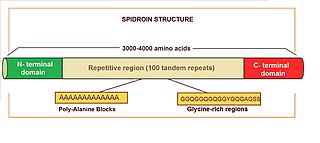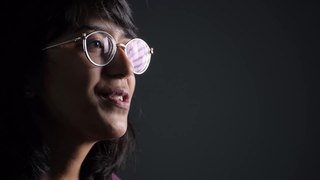
Biopolymers are natural polymers produced by the cells of living organisms. Like other polymers, biopolymers consist of monomeric units that are covalently bonded in chains to form larger molecules. There are three main classes of biopolymers, classified according to the monomers used and the structure of the biopolymer formed: polynucleotides, polypeptides, and polysaccharides. The Polynucleotides, RNA and DNA, are long polymers of nucleotides. Polypeptides include proteins and shorter polymers of amino acids; some major examples include collagen, actin, and fibrin. Polysaccharides are linear or branched chains of sugar carbohydrates; examples include starch, cellulose and alginate. Other examples of biopolymers include natural rubbers, suberin and lignin, cutin and cutan and melanin.

Yarn is a long continuous length of interlocked fibres, used in sewing, crocheting, knitting, weaving, embroidery, ropemaking, and the production of textiles. Thread is a type of yarn intended for sewing by hand or machine. Modern manufactured sewing threads may be finished with wax or other lubricants to withstand the stresses involved in sewing. Embroidery threads are yarns specifically designed for needlework. Yarn can be made of a number of natural or synthetic materials, and comes in a variety of colors and thicknesses. Although yarn may be dyed different colours, most yarns are solid coloured with a uniform hue.

Spider silk is a protein fibre spun by spiders. Spiders use their silk to make webs or other structures, which function as sticky nets to catch other animals, or as nests or cocoons to protect their offspring, or to wrap up prey. They can also use their silk to suspend themselves, to float through the air, or to glide away from predators. Most spiders vary the thickness and stickiness of their silk for different uses.

Fiber or fibre is a natural or artificial substance that is significantly longer than it is wide. Fibers are often used in the manufacture of other materials. The strongest engineering materials often incorporate fibers, for example carbon fiber and ultra-high-molecular-weight polyethylene.
Pharming, a portmanteau of "farming" and "pharmaceutical", refers to the use of genetic engineering to insert genes that code for useful pharmaceuticals into host animals or plants that would otherwise not express those genes, thus creating a genetically modified organism (GMO). Pharming is also known as molecular farming, molecular pharming or biopharming.

Natural fibers or natural fibres are fibers that are produced by geological processes, or from the bodies of plants or animals. They can be used as a component of composite materials, where the orientation of fibers impacts the properties. Natural fibers can also be matted into sheets to make paper or felt.

Modern pharmaceutical manufacturing techniques frequently rely upon biotechnology.

Animal fibers are natural fibers that consist largely of certain proteins. Examples include silk, hair/fur and feathers. The animal fibers used most commonly both in the manufacturing world as well as by the hand spinners are wool from domestic sheep and silk. Also very popular are alpaca fiber and mohair from Angora goats. Unusual fibers such as Angora wool from rabbits and Chiengora from dogs also exist, but are rarely used for mass production.

Artificial silk or art silk is any synthetic fiber which resembles silk, but typically costs less to produce. Frequently, "artificial silk" is just a synonym for rayon. When made out of bamboo viscose it is also sometimes called bamboo silk.
A dermal patch or skin patch is a medicated adhesive patch that is placed on the skin to deliver a medication into the skin. This is in contrast to a transdermal patch, which delivers the medication through the skin and into the bloodstream.

Genetically modified animals are animals that have been genetically modified for a variety of purposes including producing drugs, enhancing yields, increasing resistance to disease, etc. The vast majority of genetically modified animals are at the research stage while the number close to entering the market remains small.

Genetically modified mammals are mammals that have been genetically engineered. They are an important category of genetically modified organisms. The majority of research involving genetically modified mammals involves mice with attempts to produce knockout animals in other mammalian species limited by the inability to derive and stably culture embryonic stem cells.
Kraig Biocraft Laboratories, Inc. is an American biotechnology company headquartered in Ann Arbor, Michigan. It develops and manufactures recombinant spider silks and other high-performance polymers using spider silk gene sequences. Their most notable fiber is dragon silk which has been demonstrated to be tougher than many fibers used in bullet proof vests.

Molecular cloning is a set of experimental methods in molecular biology that are used to assemble recombinant DNA molecules and to direct their replication within host organisms. The use of the word cloning refers to the fact that the method involves the replication of one molecule to produce a population of cells with identical DNA molecules. Molecular cloning generally uses DNA sequences from two different organisms: the species that is the source of the DNA to be cloned, and the species that will serve as the living host for replication of the recombinant DNA. Molecular cloning methods are central to many contemporary areas of modern biology and medicine.
Playing God was a 2012 BBC documentary in the Horizon series, hosted by Adam Rutherford. The documentary discusses synthetic biology, the potential of science "breaking down nature into spare parts" and then rebuilding it back up as we wish.
Lisa Jean Moore is SUNY Distinguished Professor of Sociology and Gender Studies at the State University of New York, Purchase College. She was born in New York State, received a BA from Tufts University, a Masters of Public Health from the University of California, Berkeley and a PhD from the University of California, San Francisco. After receiving her doctoral degree in 1995, Moore was a fellow in the National Institutes of Mental Health, Traineeship in AIDS Prevention Sciences at the Center for AIDS Prevention Studies, the largest research center in the world dedicated to social, behavioral and policy science approaches to HIV. She lives in Crown Heights, Brooklyn with her family.

Spidroins are the main proteins in spider silk. Different types of spider silk contain different spidroins, all of which are members of a single protein family. The most-researched type of spidroins are the major ampullate silk proteins (MaSp) used in the construction of dragline silk, the strongest type of spider silk. Dragline silk fiber is made up of two types of spidroins, spidroin-1 (MaSp1) and spidroin-2 (MaSp2).
AMSilk is an industrial supplier of synthetic silk biopolymers. The polymers are biocompatible and breathable. The company was founded in 2008 and has its headquarters at the IZB in Planegg near Munich. AMSilk is an industrial biotechnology company with a proprietary production process for their silk materials.

Cellular agriculture focuses on the production of agricultural products from cell cultures using a combination of biotechnology, tissue engineering, molecular biology, and synthetic biology to create and design new methods of producing proteins, fats, and tissues that would otherwise come from traditional agriculture. Most of the industry is focused on animal products such as meat, milk, and eggs, produced in cell culture rather than raising and slaughtering farmed livestock which is associated with substantial global problems of detrimental environmental impacts, animal welfare, food security and human health. Cellular agriculture is field of the biobased economy. The most well known cellular agriculture concept is cultured meat.
Mussel foot proteins (MFP) are proteins secreted by mussels that enable them to securely anchor themselves to other mussels and other underwater structures. The proteins form sticky byssal holdfast fibers (BHF). Species from several families of clams have a byssus, including pen shells (Pinnidae), true mussels (Mytilidae), and Dreissenidae.










